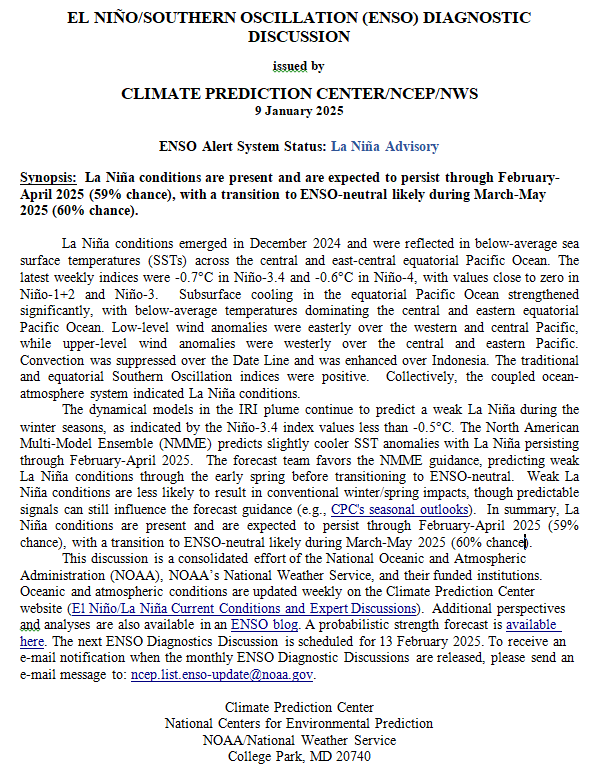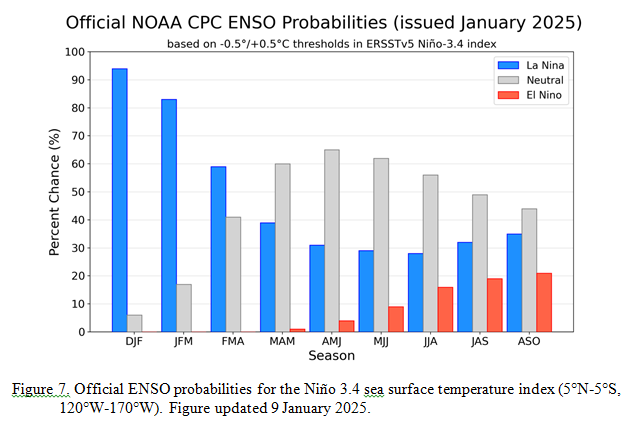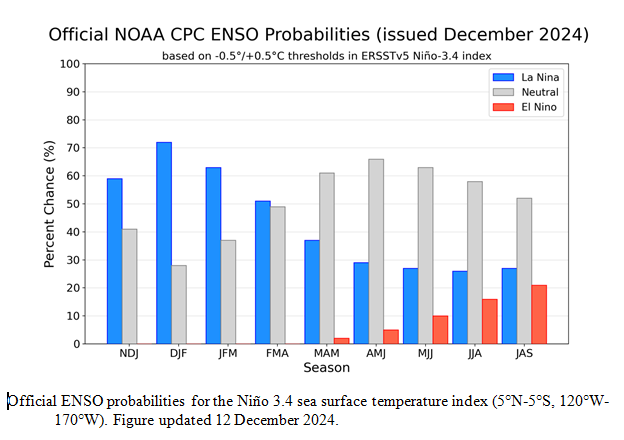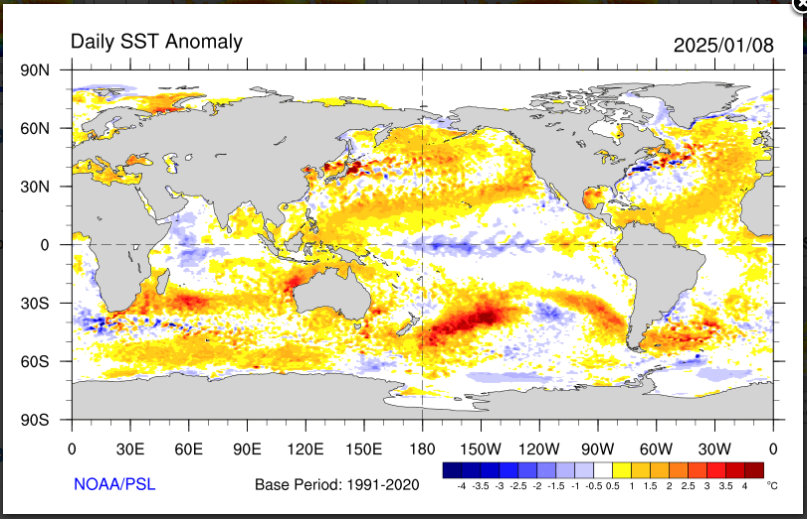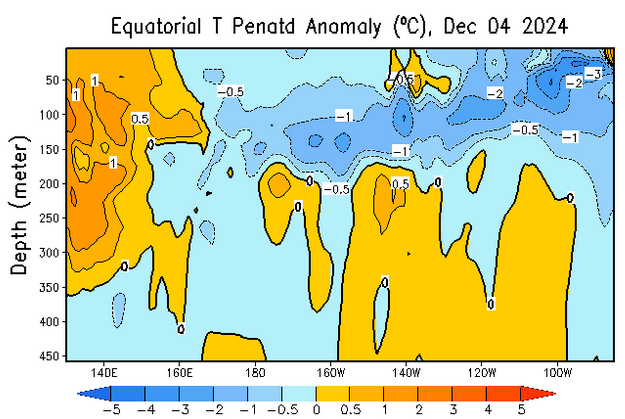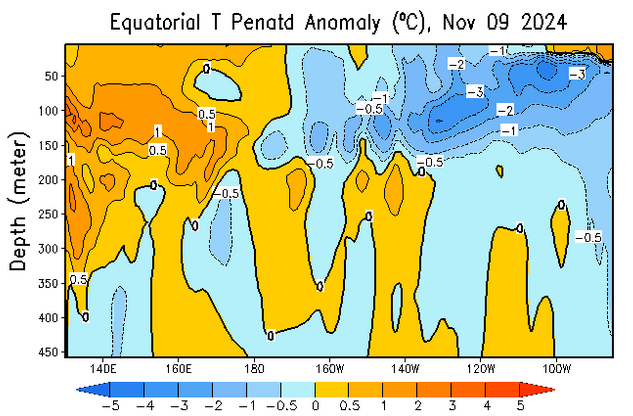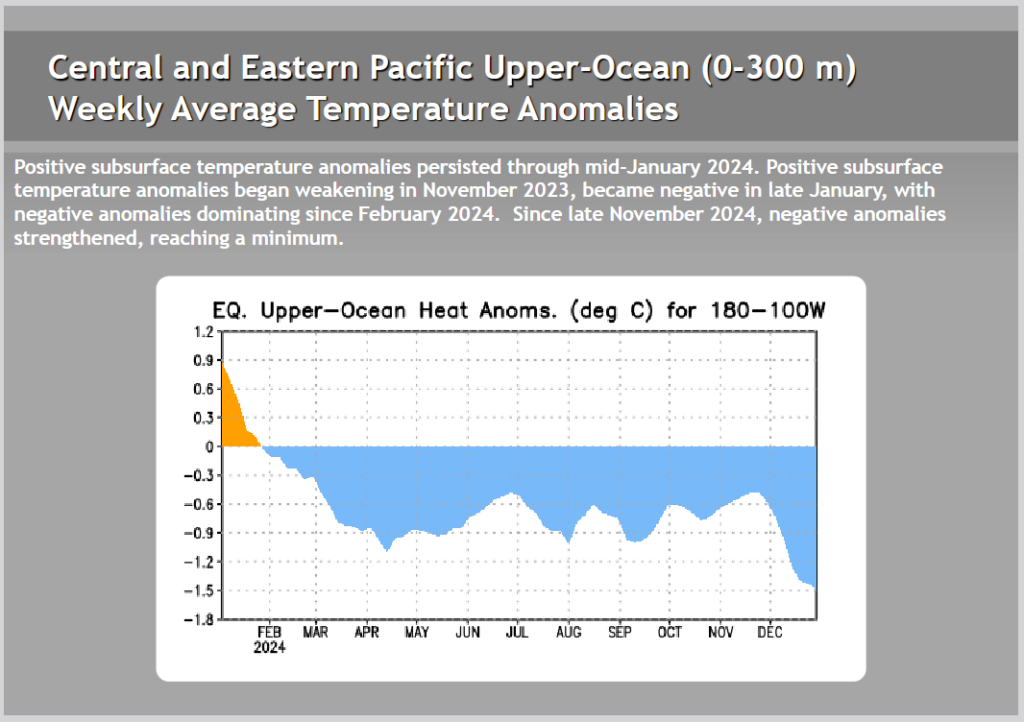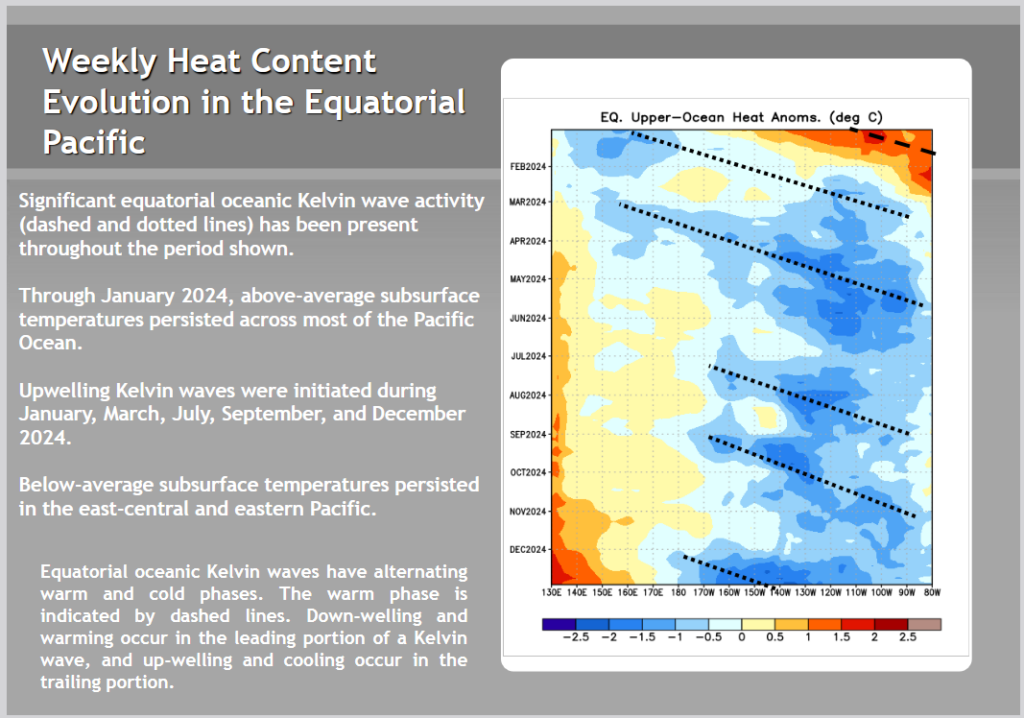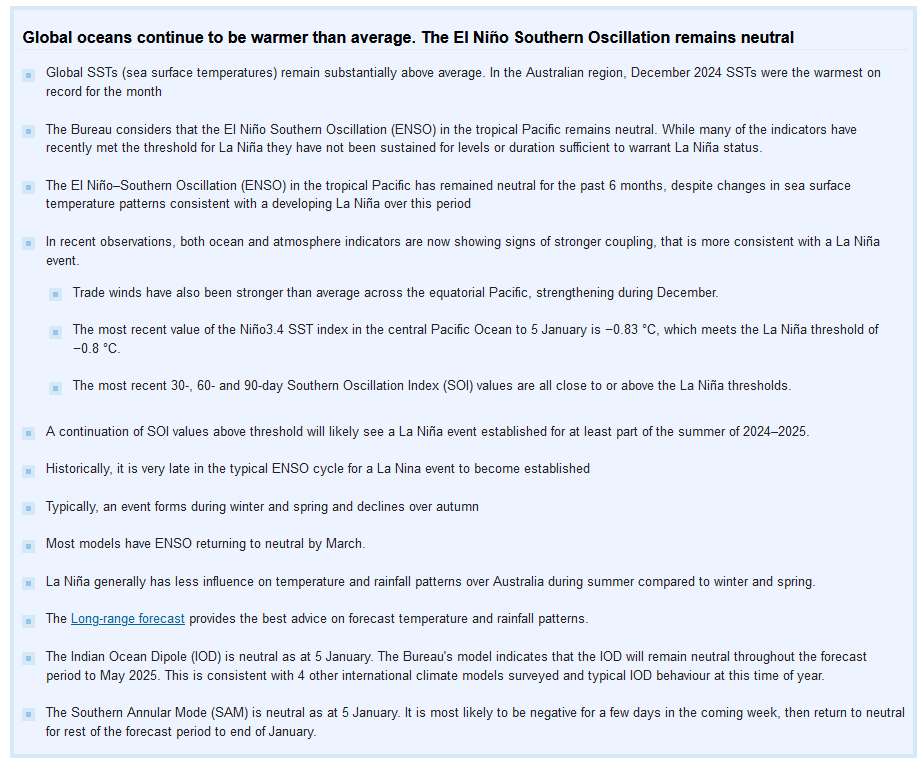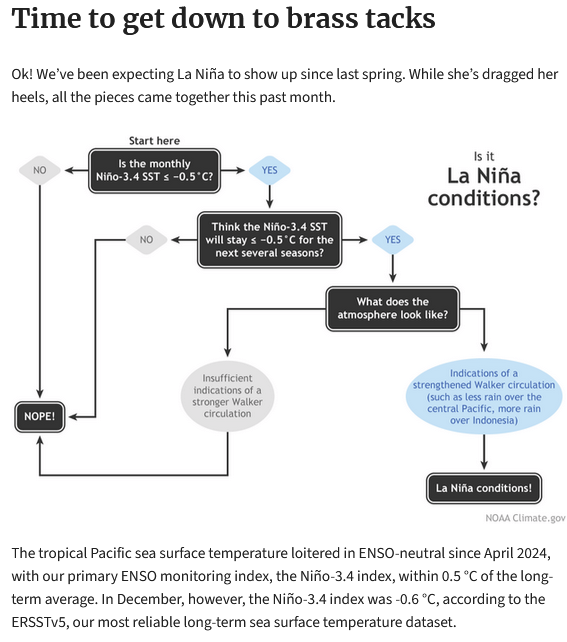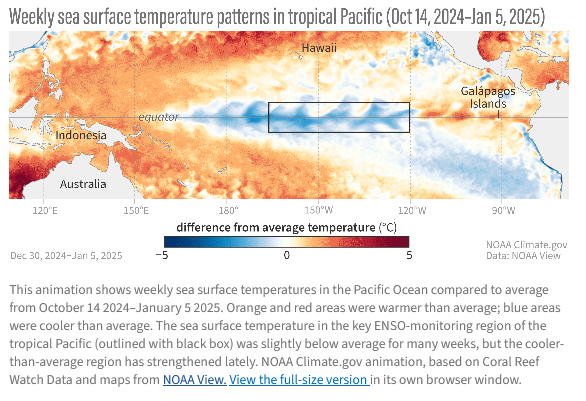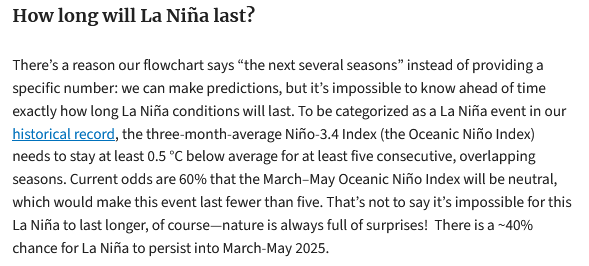“Synopsis: “La Niña conditions are present and are expected to persist through February-April 2025 (59% chance), with a transition to ENSO-neutral likely during March-May 2025 (60% chance). “
So we are no longer in ENSO Neutral but officially in La Nina (but we may not stay in La Nina long enough for it to be recorded as an official La Nina for historical purposes.)
On the second Thursday of every month, NOAA (really their Climate Prediction Center CPC) issues its analysis of the status of ENSO. This includes determining the Alert System Status. NOAA now describes their conclusion as “ENSO Alert System Status: La Nina”
It should increase the reliability of the Seasonal Outlook to be issued next Thursday. But will it?
We have included a very interesting ENSO Blog Post by Emily Becker.
CLIMATE PREDICTION CENTER ENSO DISCUSSION (LINK)
| The second paragraph is what is important:
“The dynamical models in the IRI plume continue to predict a weak La Niña during the winter seasons, as indicated by the Niño-3.4 index values less than -0.5°C . The North American Multi-Model Ensemble (NMME) predicts slightly cooler SST anomalies with La Niña persisting through February-April 2025. The forecast team favors the NMME guidance, predicting weak La Niña conditions through the early spring before transitioning to ENSO-neutral. Weak La Niña conditions are less likely to result in conventional winter/spring impacts, though predictable signals can still influence the forecast guidance (e.g., CPC’s seasonal outlooks). In summary, La Niña conditions are present and are expected to persist through February-April 2025 (59% chance), with a transition to ENSO-neutral likely during March-May 2025 (60% chance). ” Below is the middle paragraph from the discussion last month. “The dynamical models in the IRI plume continue to predict a weak and a short duration La Niña, as indicated by the Niño-3.4 index values less than -0.5°C. This prediction is also reflected in the latest North American Multi-Model Ensemble (NMME), which continues to predict slightly cooler SSTs and weak La Nina conditions. The forecast team leaned toward predicting an eventual onset of weak and short-lived La Nina conditions, based on the model guidance and current atmospheric anomalies. Weak La Niña conditions would be less likely to result in conventional winter impacts, though predictable signals could still influence the forecast guidance (e.g., CPC’s seasonal outlooks). In summary, La Niña conditions are most likely to emerge in November 2024 – January 2025 (59% chance), with a transition to ENSO-neutral most likely by March-May 2025 (61% chance).” {Author’s Note: Has anything really changed?] |
We now provide additional details.
CPC Probability Distribution
Here are the new forecast probabilities. The probabilities are for three-month periods e.g. NDJ stands for November/December/January.
![]() Here is the forecast from last month.
Here is the forecast from last month.
| The analysis this month and last month are fairly similar. But a future El Nino is a bit more in the picture. |
Some will need to click on “Read More” to read the rest of this article.
Looking at Actual Current Conditions.
NOAA reports some derived data that describes the current situation and a forecast. But what if we want to form our own opinion? After all, meteorologists are looking at the actual current situation and making predictions.
This shows the current situation for the surface of oceans. To update this graphic click HERE.
| You can see some cool water along the Equator but it is not a lot and it extends far to the west. We are discussing ENSO tonight but you can see a lot of interesting things here. It is only a one-day snapshot so keep that in mind. There is not much warm water along any coast of the United States other than the Gulf of Mexico. |
Putting the historical information in motion. Updates can be found HERE. but should not be needed.

Now we look at the below surface temperature anomalies. Mapping the details. (Cross-Section along the Equator). The data is a five-day average centered on the date shown.
Here is the new map followed by the prior two months to show the progression. The undercutting of the cool water by the warmer water is clear but when does the cool (cooler than usual meaning a cool anomaly) reach the surface? I am only showing the prior two months but the situation has been static for six or more months.
| The cool anomaly has developed a bit but what counts is the surface.. |
| This shows the water column anomaly is now negative i.e. the warmer water near the surface is dominated by the cooler water below. It has strenghtened which is probably why they declared a La Nina. |
Kelvin Waves
This is amazing. It is one tool for monitoring when the La Nina might end i.e. when we see a down-welling phase of a Kelvin Wave. |
Is the response of the atmosphere sufficient to sustain an El Nino? This made me want to take a look at the SOI Index, HERE is the U.S. version. HERE is the link to the Australia Bureau of Meteorology (BOM) version of that graph. I prefer the BOM version but there could be an argument that the U.S. version is more accurate but I am not convinced of that. The BOM version dates back to when meteorological stations were more practical on land so they were not exactly on the Equator as is the U.S. version.
With respect to the BOM version,
“The Southern Oscillation Index, or SOI, gives an indication of the development and intensity of El Niño or La Niña events in the Pacific Ocean. The SOI is calculated using the pressure differences between Tahiti and Darwin.
Sustained negative values of the SOI below −7 often indicate El Niño episodes. These negative values are usually accompanied by sustained warming of the central and eastern tropical Pacific Ocean, a decrease in the strength of the Pacific Trade Winds, and a reduction in winter and spring rainfall over much of eastern Australia and the Top End. You can read more about historical El Niño events and their effect on Australia in the Detailed analysis of past El Niño events.
Sustained positive values of the SOI above +7 are typical of a La Niña episode. They are associated with stronger Pacific trade winds and warmer sea temperatures to the north of Australia. Waters in the central and eastern tropical Pacific Ocean become cooler during this time. Together these give an increased probability that eastern and northern Australia will be wetter than normal. You can read more about historical La Niña events and their effect on Australia in the Detailed analysis of past La Niña events.”
http://www.bom.gov.au/clim_data/IDCKGSM000/soi30.png
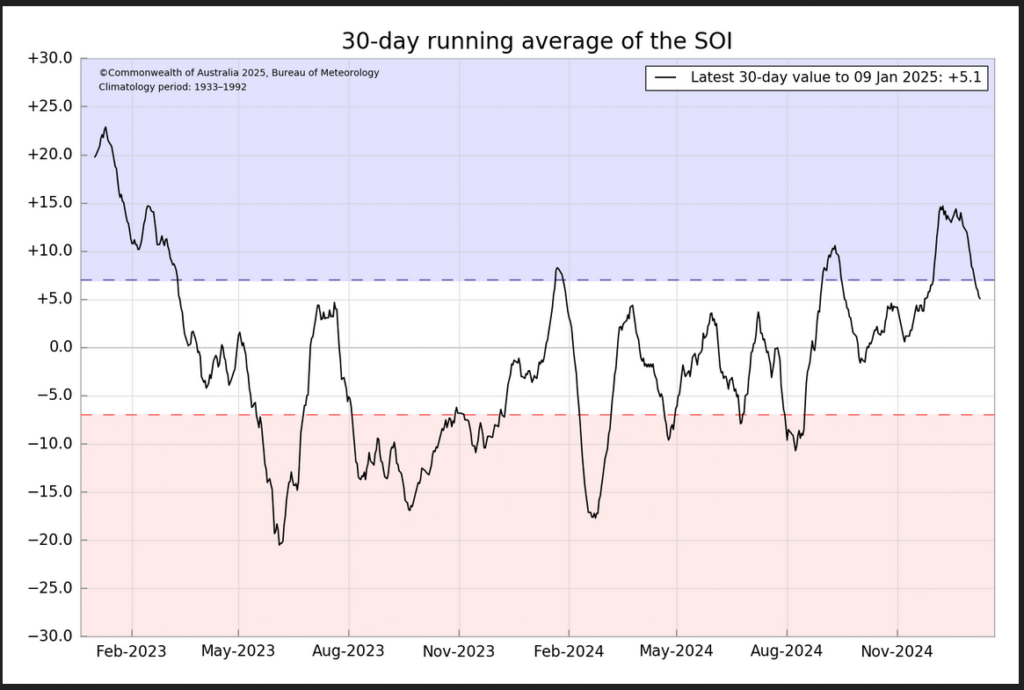
| The SOI is now in La Nina territory. |
Assessment of the Australian Bureau of Meteorology (BOM) LINK.
| The Australian Bureau of Meteorology has not declared La Nina but their criteria are a bit stricter than used by the U.S.. Overall, it is basically the same as the U.S.. analysis. |
Assessment of JAMSTEC (I have not received that yet)/
Now we present the recent ENSO Blog Post by Emily Becker. (You can read her full article HERE)
| In the above the positive decision that 3.4 will meet the threshold for several seasons and when they discuss the Atmosphere they do not mention the SOI here but they do in the summary at the beginning of the article and the SOI is NOT IN LA NINA TERRITORY AS WAS CLAIMED. It is close but NOAA has stretched to call this a La Nina IMO. |
| You can see that the cold water (anomaly) extends to the west of the El Nino measurement area suggesting that the Walker Circulation will be a bit different than for a typical La Nina. |
| I hope you found this article interesting and useful. |

